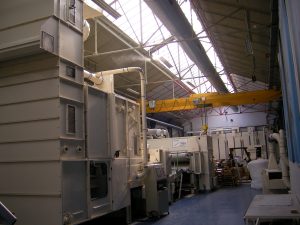Textile
Nonwoven manufacturing process
Process
The nonwoven fabrics consist of various interconnected web structures developed through various stages within the textile nonwoven manufacturing process, such as:
- intertwining the fibers mechanically,
- thermal bonding chemical fusing,
- stitching, etc.
These fabrics are man-made, thus transforming them into yarn is not possible. As an example, one of the nonwoven fabrics is felt. Furthermore, the felt fabrics are not knitted, nor woven.
There are two main stages within the nonwoven manufacturing process, responsible for the production of the nonwoven fabrics:
- Web formation: carding, air laying, spun bonding, electro-spinning, etc.
- Web consolidation: needle punching, spun lacing, chemical and thermal bounding, etc.
These two processes generally operate separately, however, it is also feasible to merge them into a singular process.
Furthermore, the manufacturing of nonwoven materials depends mostly on the type of application, whether it is for industrial or consumer usage. Thus, the fabric can differ in terms of density, weight and structure.
Solutions
Ikeuchi’s solutions for the nonwoven manufacturing process
The AKIMist is one solution that can be applicable in the nonwoven process, as its Dry Fog facilitates various benefits through its implementation. These benefits relate to the optimal humidification and temperature management which leads to the prevention of ESD from occurring. In addition, it enhances the efficiency and effectiveness of the processes, as the machineries’ wellbeing are preserved. This minimizes, and eliminates the development of :
- duct clogging,
- fabric cracks, and
- web curling.
Moreover, within the finishing treatment segment of the non-woven process, the implementation of the following nozzle series, can assist with the coating operations:
- SO-V: stainless steal nozzle body, equipped with a ceramic orifice;
- SO-VV: completely fabricated out of stainless steel.
These two series offer an ON/OFF response and spraying, which allows you to regulate the spraying frequency and quantity for coating. Furthermore, their flat spray tapered edge pattern ensures that the pulverization covers the surface of the nonwoven fabric in an equal manner.

